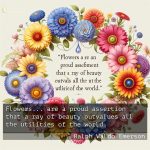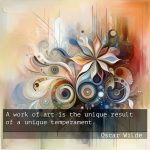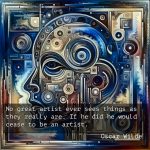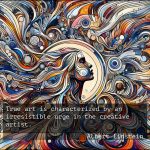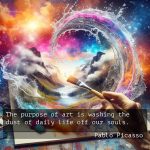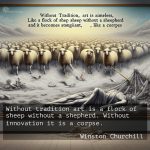This website uses cookies so that we can provide you with the best user experience possible. Cookie information is stored in your browser and performs functions such as recognising you when you return to our website and helping our team to understand which sections of the website you find most interesting and useful.

Ralph Waldo Emerson Quotes on Art
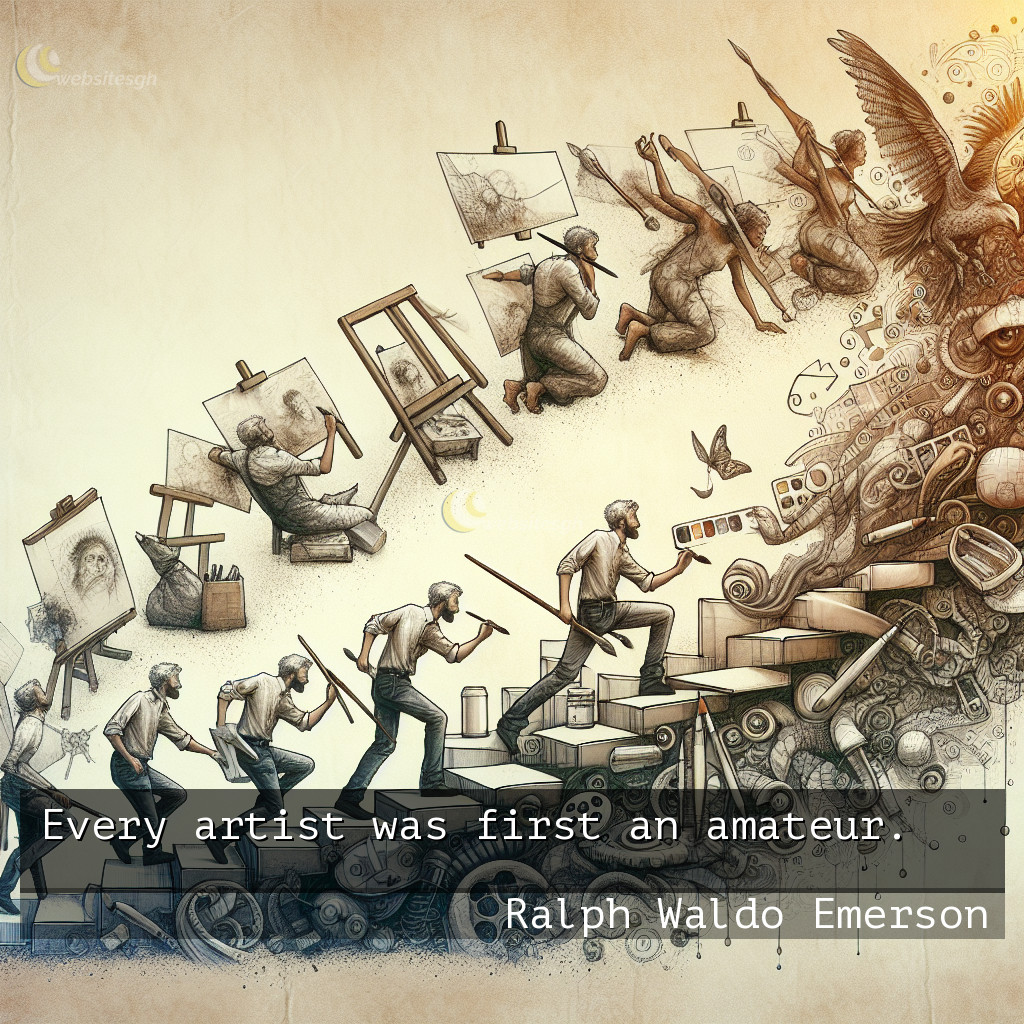
Ralph Waldo Emerson Quotes on Art Oc7R
Every artist was first an amateur.
By: Ralph Waldo Emerson
The Journey from Amateur to Artist
The path from amateur to artist is one of transformation, a metamorphosis that involves not only the honing of skills but also the evolution of the self. The words of Ralph Waldo Emerson, “Every artist was first an amateur,” serve as a powerful reminder that the journey towards mastery is universal and accessible to all who are willing to embark on it.
This journey is not exclusive to the traditional realms of painting, music, or literature. It extends to every aspect of life where there is a craft to be learned, a skill to be developed, or a passion to be pursued. Whether you are a young student, an aspiring entrepreneur, or someone looking to make a positive change in your life, the transformation from amateur to artist is a path that promises growth, fulfillment, and the joy of creation.
Embracing the Amateur Within
The term ‘amateur’ often carries a negative connotation, suggesting a lack of skill or seriousness. However, the root of the word amateur is the Latin ‘amator,’ meaning lover. An amateur, then, is someone who engages in an activity for the love of it, not necessarily for compensation or professional recognition. This love is the fuel that drives the amateur to explore, to learn, and to persist.
The amateur stage is a time of exploration and discovery. It is a period where mistakes are not just inevitable but are also invaluable learning opportunities. The amateur is free to experiment without the weight of expectation, which often leads to innovation and a unique voice or style. Embracing your inner amateur means giving yourself permission to be imperfect, to ask questions, and to take risks.
The Transformation Process
The transformation from amateur to artist is not a linear process; it is cyclical and iterative. It involves a series of steps that you will revisit and refine over time. Here is a simplified outline of the process:
- Learning the Basics: This is where you build a foundation. You learn the rules, the techniques, and the history of your craft.
- Practice: With the basics under your belt, you begin the repetitive process of practice. This is where muscle memory and intuition start to develop.
- Experimentation: Once you are comfortable with the fundamentals, you start to experiment. You push boundaries and try new things to find what resonates with you.
- Reflection: After experimenting, you take a step back to reflect on what worked and what didn’t. This is a critical phase for learning and growth.
- Integration: You take what you’ve learned from reflection and integrate it into your practice, refining your technique and approach.
- Sharing: Eventually, you reach a point where you are ready to share your work with others, opening yourself up to feedback and the possibility of influencing others.
This process is not a one-time journey but a continuous loop. Even the most accomplished artists return to the basics, practice relentlessly, experiment with new ideas, reflect on their work, integrate their findings, and share their evolved creations.
Overcoming Challenges
The road from amateur to artist is fraught with challenges. Self-doubt, criticism, and the fear of failure are common companions along the way. However, these challenges are not roadblocks; they are stepping stones. Each challenge overcome is a victory that adds to your resilience and character.
One of the most effective ways to overcome these challenges is to adopt a growth mindset. This means viewing your abilities as capable of development rather than fixed traits. With a growth mindset, challenges become opportunities to improve, and effort is seen as the path to mastery.
Staying Motivated
Motivation can be elusive, especially when progress seems slow or when faced with setbacks. To stay motivated, it’s important to set clear, achievable goals and to celebrate the small victories along the way. Remember why you started and keep the love for your craft at the forefront of your mind.
Another key to staying motivated is to surround yourself with a supportive community. This could be a group of peers who are on a similar journey, a mentor who can provide guidance, or even an audience that appreciates your work. A community can provide encouragement, constructive feedback, and a sense of belonging.
Life as an Ongoing Art
The transformation from amateur to artist is not just about achieving a level of proficiency in a particular field. It’s about adopting an artistic approach to life itself. Life, like art, is a canvas on which we are constantly creating and recreating ourselves. We are all works in progress, and the pursuit of any form of art is a metaphor for the pursuit of life.
In the end, the distinction between amateur and artist fades away. What remains is the continuous journey of learning, creating, and expressing. Ralph Waldo Emerson’s insight reminds us that we all start somewhere, and with passion, practice, and perseverance, we can all become artists in our own right.
FAQs about Ralph Waldo Emerson on Art
- What did Ralph Waldo Emerson mean by saying “Every artist was first an amateur”?
Emerson meant that all skilled artists started as beginners who gradually developed their craft through practice and dedication. The quote emphasizes that mastery is a process that begins with a love for the art and a willingness to learn.
- How can I apply Emerson’s quote to my life if I’m not an artist?
The quote can be applied to any skill or endeavor. It suggests that everyone starts as a beginner and can achieve proficiency or even mastery through consistent effort and passion, regardless of the field.
- Is it important to have natural talent to become an artist?
While natural talent can be beneficial, Emerson’s quote suggests that passion, practice, and perseverance are more important in the journey from amateur to artist. Many successful artists have achieved greatness through hard work rather than innate talent alone.
- How can I embrace being an amateur?
Embrace being an amateur by allowing yourself to explore and learn without fear of making mistakes. Enjoy the process of discovery and remember that every expert once started as a beginner.
- What are some challenges I might face on the path from amateur to artist?
Common challenges include self-doubt, criticism, fear of failure, and periods of slow progress. Overcoming these challenges involves persistence, a growth mindset, and viewing setbacks as learning opportunities.
- How can I stay motivated when progress seems slow?
Set clear, achievable goals, celebrate small victories, remember your initial passion, and engage with a supportive community. These strategies can help maintain motivation throughout your journey.
- What does it mean to have a growth mindset?
A growth mindset is the belief that your abilities and intelligence can be developed through dedication and hard work. It’s the opposite of a fixed mindset, which assumes that talents and abilities are static and unchangeable.
- Can the journey from amateur to artist be a linear process?
No, the journey is often cyclical and iterative, involving learning, practice, experimentation, reflection, integration, and sharing. Even accomplished artists revisit these steps to continue growing.
- Why is reflection important in the transformation from amateur to artist?
Reflection allows you to assess what you’ve learned, understand what works and what doesn’t, and integrate these insights into your future work. It’s a critical phase for growth and improvement.
- How can I find a supportive community for my artistic journey?
Look for local or online groups that share your interests, attend workshops or classes, seek out mentors, and engage with platforms where you can share your work and receive feedback.
